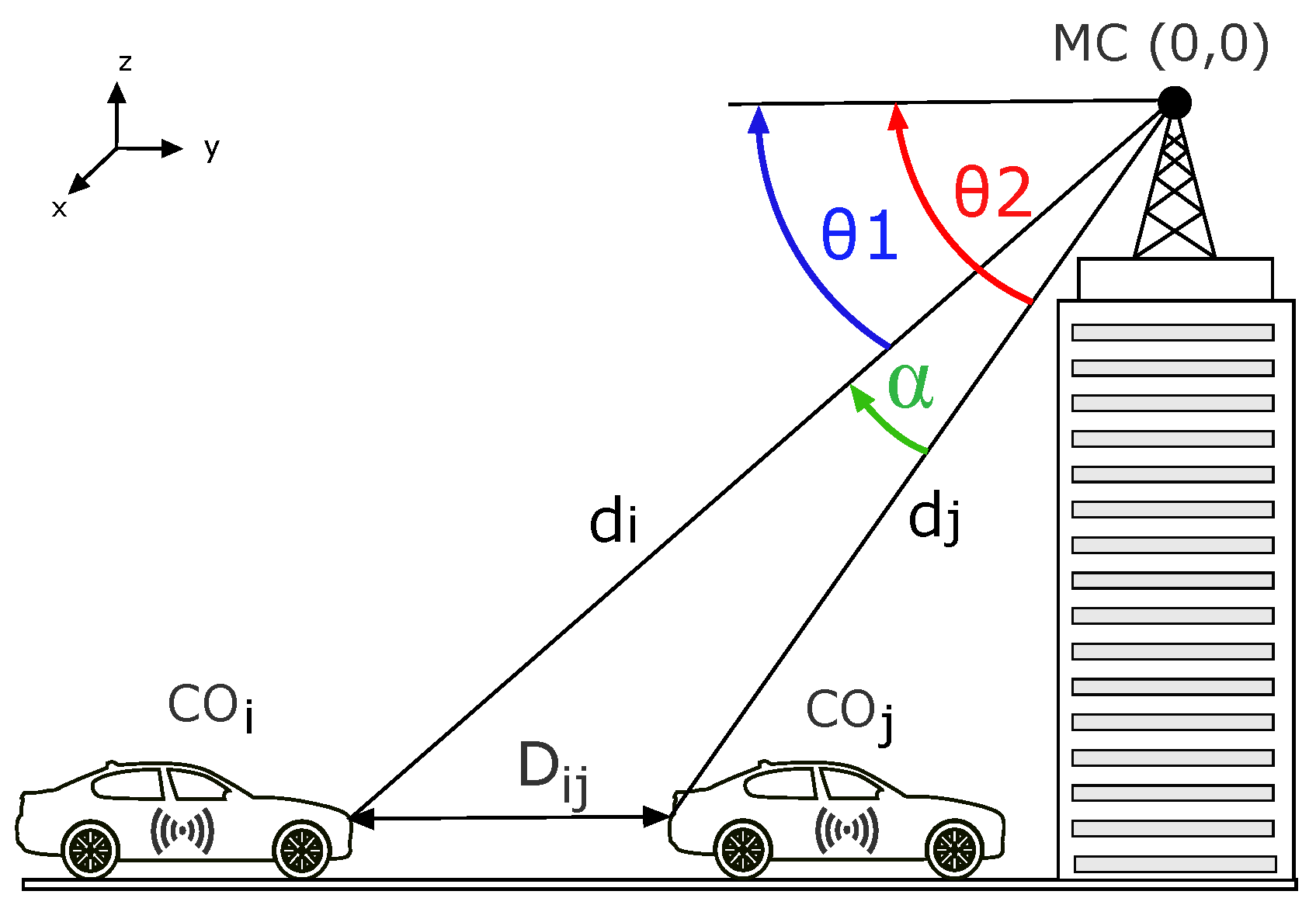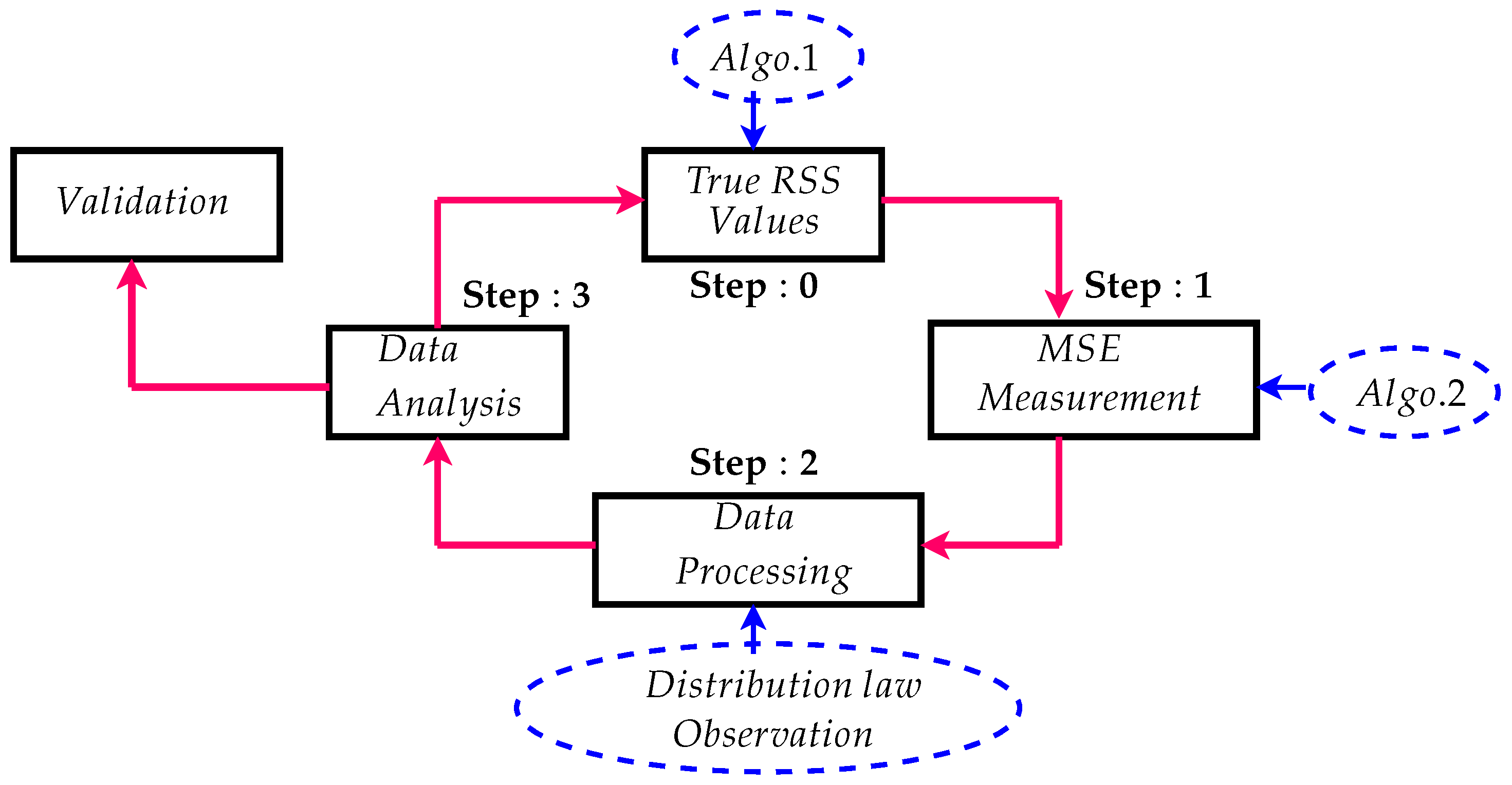Connected Objects Geo-Localization Based on SS-RSRP of 5G Networks
Abstract
:1. Introduction
- We demonstrated analytically and by simulation that the proposed algorithm gives good accuracy when approaching the 0.55 m barrier. This barrier has never been reached in previous works.
- We have full knowledge of the error distribution, as it follows the Rayleigh law. This knowledge will help to tune the solution to other positioning scenarios and applications.
- The CRLB is derived to showcase the robustness of the proposed estimator at low and high SNR. Theoretical analysis and simulation both confirm the validity of the proposed model.
2. System Model
2.1. Path Loss Model
2.2. SS-RSRP Model
- 1
- We will assume in this paper, that there is no cable losses to simplify the calculation process. Hence .
- 2
- The antenna gain depends on the direction of arrival to the Macro-Cell (MC) [25].
3. Distance Estimation
| Algorithm 1 Simulation of a realistic RSS environment |
|
| Algorithm 2 Distance Estimation in 5G NR |
|
4. Numerical Results and Validation
4.1. MSE Method
4.2. Accuracy Quantification
4.3. Complexity and Performance Analysis
4.4. CRLB Analysis
5. Conclusions
Author Contributions
Funding
Institutional Review Board Statement
Informed Consent Statement
Data Availability Statement
Conflicts of Interest
References
- Henk, W.; Gonzalo, S.G.; Giuseppe, D.; Davide, D.; Fredrik, T. 5G mmWave Positioning for Vehicular Networks. IEEE Wirel. Commun. 2017, 24, 80–86. [Google Scholar]
- Spirito, M.; Poykko, S.; Knuuttila, O. Experimental Performance of Methods to Estimate the Location of Legacy Handsets in GSM. In Proceedings of the IEEE 54th Vehicular Technology Conference. VTC Fall 2001. Proceedings (Cat. No.01CH37211), Atlantic City, NJ, USA, 7–11 October 2001; Volume 4, pp. 2716–2720. [Google Scholar] [CrossRef]
- Borkowski, J.; Niemela, J.; Lempiainen, J. Enhanced Performance of Cell ID+RTT by Implementing Forced Soft Handover Algorithm. In Proceedings of the IEEE 60th Vehicular Technology Conference, 2004. VTC2004-Fall. 2004, Los Angeles, CA, USA, 26–29 September 2004; Volume 5, pp. 3545–3549. [Google Scholar] [CrossRef]
- Wennervirta, J.; Wigren, T. RTT Positioning Field Performance. IEEE Trans. Veh. Technol. 2010, 59, 3656–3661. [Google Scholar] [CrossRef]
- Sadowski, J. TDOA navigation Using CDMA2000 Signals “Experimental results”. In Proceedings of the 2014 Ubiquitous Positioning Indoor Navigation and Location Based Service (UPINLBS), Corpus Christi, TX, USA, 20–21 November 2014; pp. 265–271. [Google Scholar] [CrossRef]
- Duffett-Smith, P.J.; Tarlow, B. E-GPS: Indoor Mobile Phone Positioning on GSM and W-CDMA. In Proceedings of the 18th International Technical Meeting of the Satellite Division of The Institute of Navigation (ION GNSS 2005), Long Beach, CA, USA, 13–16 September 2005; pp. 2762–2768. [Google Scholar]
- Gioia, C.; Borio, D. Stand-alone and Hybrid Positioning Using Asynchronous Pseudolites. Sensors 2015, 15, 166–193. [Google Scholar] [CrossRef] [PubMed] [Green Version]
- Bartoletti, S.; Conti, A.; Dardari, D.; Giorgetti, A. 5G Localization And Context-Awareness; University of Bologna: Bologna, Italy, 2018. [Google Scholar]
- Guerra, A.; Guidi, F.; Dardari, D. Position and Orientation Error Bound For Wideband Massive Antenna Arrays. In Proceedings of the 2015 IEEE International Conference on Communication Workshop (ICCW), London, UK, 8–12 June 2015; pp. 853–858. [Google Scholar]
- Wen, F.; Wymeersch, H.; Peng, B.; Tay, W.P.; So, H.C.; Yang, D. A Survey On 5G Massive MIMO Localization. Digit. Signal Process. 2019, 94, 21–28. [Google Scholar] [CrossRef] [Green Version]
- Shahmansoori, A.; Garcia, G.E.; Destino, G.; Seco-Granados, G.; Wymeersch, H. 5G Position And Orientation Estimation Through Millimeter Wave MIMO. In Proceedings of the 2015 IEEE Globecom Workshops (GC Wkshps), San Diego, CA, USA, 6–10 December 2015; pp. 1–6. [Google Scholar]
- Savic, V.; Larsson, E.G. Fingerprinting-based Positioning in Distributed Massive MIMO Systems. In Proceedings of the 2015 IEEE 82nd Vehicular Technology Conference (VTC2015-Fall), Boston, MA, USA, 6–9 September 2015; pp. 1–5. [Google Scholar]
- Wang, W.; Jost, T.; Gentner, C.; Zhang, S.; Dammann, A. A Semiblind Tracking Algorithm For Joint Communication and Ranging with OFDM Signals. IEEE Trans. Veh. Technol. 2015, 65, 5237–5250. [Google Scholar] [CrossRef]
- Witrisal, K.; Hinteregger, S.; Kulmer, J.; Leitinger, E.; Meissner, P. High-Accuracy Positioning for Indoor Applications: RFID, UWB, 5G, and Beyond. In Proceedings of the 2016 IEEE International Conference on RFID (RFID), Orlando, FL, USA, 3–5 May 2016; pp. 1–7. [Google Scholar]
- Gentner, C.; Jost, T.; Wang, W.; Zhang, S.; Dammann, A.; Fiebig, U.C. Multipath Assisted Positioning with Simultaneous Localization and Mapping. IEEE Trans. Wirel. Commun. 2016, 15, 6104–6117. [Google Scholar] [CrossRef] [Green Version]
- Dammann, A.; Raulefs, R.; Zhang, S. On Prospects of Positioning in 5G. In Proceedings of the 2015 IEEE International Conference on Communication Workshop (ICCW), London, UK, 8–12 June 2015; pp. 1207–1213. [Google Scholar]
- Koivisto, M.; Costa, M.; Werner, J.; Heiska, K.; Talvitie, J.; Leppänen, K.; Koivunen, V.; Valkama, M. Joint Device Positioning and Clock Synchronization in 5G Ultra-Dense Networks. IEEE Trans. Wirel. Commun. 2017, 16, 2866–2881. [Google Scholar] [CrossRef] [Green Version]
- Hakkarainen, A.; Werner, J.; Costa, M.; Leppanen, K.; Valkama, M. High-Efficiency Device Localization in 5G Ultra-Dense Networks: Prospects And Enabling Technologies. In Proceedings of the 2015 IEEE 82nd Vehicular Technology Conference (VTC2015-Fall), Boston, MA, USA, 6–9 September 2015; pp. 1–5. [Google Scholar]
- Koivisto, M.; Hakkarainen, A.; Costa, M.; Kela, P.; Leppanen, K.; Valkama, M. High-Efficiency Device Positioning and Location-Aware Communications in Dense 5G Networks. IEEE Commun. Mag. 2017, 55, 188–195. [Google Scholar] [CrossRef] [Green Version]
- Khan, M.A.; Saeed, N.; Ahmad, A.W.; Lee, C. Location Awareness in 5G Networks Using RSS Measurements for Public Safety Applications. IEEE Access 2017, 5, 21753–21762. [Google Scholar] [CrossRef]
- Talvitie, J.; Koivisto, M.; Levanen, T.; Ihalainen, T.; Pajukoski, K.; Valkama, M. Radio Positioning and Tracking of High-Speed Devices in 5G NR Networks: System Concept and Performance. In Proceedings of the 2019 27th European Signal Processing Conference (EUSIPCO), A Coruña, Spain, 2–6 September 2019; pp. 1–5. [Google Scholar] [CrossRef]
- Wang, D.; Hosangadi, G.; Monogioudis, P.; Rao, A. Mobile Device Localization in 5G Wireless Networks. In Proceedings of the 2019 International Conference on Computing, Networking and Communications (ICNC), Honolulu, HI, USA, 18–21 February 2019. [Google Scholar]
- Hyowon, K.; Karl, G.; Lin, G.; Giorgio, B.; Sunwoo, K.; Henk, W. 5G mmWave Cooperative Positioning and Mapping using Multi-Model PHD Filter and Map Fusion. IEEE Trans. Wirel. Commun. 2020, 19, 3782–3795. [Google Scholar]
- Yarkan, S.; Guzelgoz, S.; Arslan, H.; Murphy, R. Underground Mine Communications: A Survey. IEEE Commun. Surv. Tutor. 2009, 11, 125–142. [Google Scholar] [CrossRef]
- Kangas, A.; Wigren, T. Angle of Arrival Localization in LTE Using MIMO Pre-Coder Index Feedback. IEEE Commun. Lett. 2013, 17, 1584–1587. [Google Scholar] [CrossRef]
- Guerreiro, J.; Dinis, R.; Montezuma, P. On the Optimum Performance of CE-OFDM Schemes in Frequency-Selective Channels. In Proceedings of the 2016 International Conference on Telecommunications and Multimedia, TEMU 2016, Heraklion, Crete, Greece, 25–27 July 2016; pp. 1–6. [Google Scholar]
- Ahmed, B.; Sun, Y.M.; Lassad, A.; Fabien, D.; Ridha, B. A Novel Algebraic Carrier Frequency Offset Estimator for ASTC-MIMO-OFDM Systems over a Correlated Frequency-Selective Channel. IEEE Trans. Veh. Technol. 2012, 61, 2468–2475. [Google Scholar]
- 3GPP. Technical Specification Group Services and System Aspects; Release 15 Description; Summary of Rel-15 Work Items; Technical Report 15.0.0; Version 14.2.2; 3rd Generation Partnership Project (3GPP): Sophia Antipolis, France, 2019. [Google Scholar]






| System Parameter | Parameter Value |
|---|---|
| Channel mode | TDL-D |
| Bandwidth | 20 MHz |
| Number of subcarriers | 3300 |
| Extended Cyclic Prefix | 2048 |
| Subcarrier spacing | 60 kHz |
Publisher’s Note: MDPI stays neutral with regard to jurisdictional claims in published maps and institutional affiliations. |
© 2021 by the authors. Licensee MDPI, Basel, Switzerland. This article is an open access article distributed under the terms and conditions of the Creative Commons Attribution (CC BY) license (https://creativecommons.org/licenses/by/4.0/).
Share and Cite
Bannour, A.; Harbaoui, A.; Alsolami, F. Connected Objects Geo-Localization Based on SS-RSRP of 5G Networks. Electronics 2021, 10, 2750. https://doi.org/10.3390/electronics10222750
Bannour A, Harbaoui A, Alsolami F. Connected Objects Geo-Localization Based on SS-RSRP of 5G Networks. Electronics. 2021; 10(22):2750. https://doi.org/10.3390/electronics10222750
Chicago/Turabian StyleBannour, Ahmed, Ahmed Harbaoui, and Fawaz Alsolami. 2021. "Connected Objects Geo-Localization Based on SS-RSRP of 5G Networks" Electronics 10, no. 22: 2750. https://doi.org/10.3390/electronics10222750






